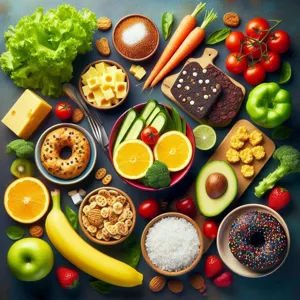In a world where convenience often trumps nutrition, the prevalence of processed foods has reached unprecedented levels, making it all too easy to compromise on health.
Many of us find ourselves reaching for pre-packaged snacks and quick meals, often neglecting the wholesome goodness that fresh, unprocessed ingredients can offer. However, making the switch to a healthier diet doesn’t have to be overwhelming. In this blog post, we will explore 10 simple yet effective strategies to help you cut down on processed foods and embrace a more nutritious lifestyle. From meal prepping to discovering delicious alternatives, these practical tips will empower you to take control of your eating habits, boost your energy levels, and ultimately lead to a happier, healthier you. Join us on this journey towards better eating and discover the joy of nourishing your body with real, wholesome foods!
1. Understanding Processed Foods: What to Look For

Understanding processed foods is the first step towards making healthier dietary choices. Processed foods are typically items that have been altered from their natural state through methods such as canning, freezing, refrigeration, dehydration, and packaging. While not all processing is harmful—think of the preservation of fruits and vegetables—many processed foods contain additives that can detract from their nutritional value.
When evaluating whether a food is processed, start by reading the ingredient list. A good rule of thumb is to opt for products with ingredients that you can easily recognize and pronounce. If the list reads like a chemistry experiment, it’s likely laden with preservatives, artificial flavors, and other additives that can contribute to health issues over time. Look out for terms like high fructose corn syrup, hydrogenated oils, and sodium nitrates. These are red flags that indicate a product may be heavily processed.
Furthermore, pay attention to the nutritional information. A high sugar or sodium content often indicates a processed item. Aim to choose foods that are low in added sugars and sodium, and rich in fiber, protein, and healthy fats. Fresh produce, whole grains, lean meats, and unprocessed dairy should become staples in your pantry.
By developing a keen eye for what constitutes processed foods, you can make informed choices that prioritize your health while gradually moving towards a diet rich in whole, nourishing ingredients. This foundational understanding will empower you to navigate grocery store aisles with confidence, helping you cut down on processed foods and embrace a healthier lifestyle.
2. The Benefits of Eating Whole Foods
Eating whole foods provides a plethora of benefits that extend beyond mere nutrition; it fundamentally transforms the way you think about food and its impact on your overall health. Whole foods, which include fresh fruits, vegetables, whole grains, nuts, seeds, and lean proteins, are packed with essential nutrients that support your body’s functions and promote vitality.
Firstly, whole foods are typically rich in vitamins, minerals, antioxidants, and fiber. These nutrients not only nourish your body but also help to reduce the risk of chronic diseases such as heart disease, diabetes, and certain cancers. For instance, the fiber found in whole foods aids digestion, helps maintain a healthy weight, and keeps you feeling fuller for longer, making it easier to resist the temptation of processed snacks.
Moreover, whole foods are usually less calorically dense compared to their processed counterparts, meaning you can eat satisfying portions without overindulging. This is largely due to their natural composition, which includes water and fiber that contribute to a feeling of fullness. As a result, incorporating more whole foods into your meals can assist in weight management and promote a healthier lifestyle.
Additionally, eating whole foods fosters a deeper connection with what you consume. By choosing ingredients that are minimally processed or untouched, you become more mindful of the food journey, from farm to plate. This awareness encourages you to appreciate the flavors and textures of natural ingredients, leading to a more satisfying and pleasurable dining experience.
Lastly, embracing whole foods can significantly impact your mental well-being. Studies have shown that diets rich in whole, nutrient-dense foods are linked to improved mood and cognitive function. By nourishing your body with wholesome ingredients, you may also find yourself feeling more energized and ready to tackle the day ahead.
Incorporating whole foods into your diet is not just a change in what you eat; it’s a holistic approach to a healthier lifestyle that can lead to long-lasting benefits for both your body and mind. So, let’s dive into the world of whole foods and discover how simple changes can lead to profound improvements in your health.
3. Meal Planning: Preparing for Success

Meal planning is a pivotal strategy in the quest to cut down on processed foods and embrace a healthier lifestyle. By taking the time to plan your meals for the week ahead, you not only streamline your grocery shopping but also set yourself up for culinary success. Imagine standing in front of your refrigerator, armed with a well-thought-out list of fresh ingredients and recipes that excite your taste buds, rather than succumbing to the temptation of quick, pre-packaged options.
Start by dedicating a few minutes each week to sketch out your meals. Consider incorporating a variety of colorful fruits and vegetables, lean proteins, and whole grains into your plan. This not only ensures that your meals are nutritious but also keeps them vibrant and enjoyable. By mapping out breakfast, lunch, dinner, and snacks, you create a structure that makes healthy eating both accessible and appealing.
Another essential aspect of meal planning is batch cooking. Set aside time on the weekends to prepare larger portions of your favorite dishes, such as hearty soups, stews, or grain bowls. Not only does this save time during busy weekdays, but it also allows you to control the ingredients, ensuring that you’re using wholesome, unprocessed components. Store these prepped meals in portion-sized containers, and you’ll have convenient, nutritious options ready to go, eliminating the need to reach for processed convenience foods.
Additionally, don’t forget the power of versatility. When planning, consider meals that can easily be adapted or transformed throughout the week. For example, grilled chicken can be the star of a salad one day and a filling taco the next. This keeps your meals interesting and minimizes food waste, as you can strategically use leftovers in new and creative ways.
By embracing meal planning, you not only simplify your week and save money, but you also cultivate a deeper connection with your food. This proactive approach empowers you to make healthier choices and reduces the likelihood of reaching for processed snacks or meals in moments of hunger or fatigue. With each meal you plan, you’re taking a significant step towards a healthier you.
4. Stocking Your Pantry with Healthy Staples
Stocking your pantry with healthy staples is a foundational strategy in your journey toward healthier eating. The key to reducing processed foods lies in having the right ingredients at your fingertips, making it easier to whip up nutritious meals at home.
Begin by assessing what staples align with your dietary preferences and health goals. Whole grains like quinoa, brown rice, and whole-wheat pasta should be primary contenders. These grains provide essential fiber, keeping you full longer and aiding in digestion. Next, consider canned or dried legumes such as chickpeas, lentils, and black beans. Not only are they versatile and protein-rich, but they also serve as a hearty base for salads, soups, and stews.
Fruits and vegetables are crucial, but it’s often challenging to keep fresh produce on hand without a plan for consumption. Instead, stock up on frozen fruits and vegetables, which retain their nutrients and can be easily added to smoothies, stir-fries, or casseroles. Don’t forget about healthy fats—keep olive oil, nut butters, and a selection of nuts and seeds in your pantry. These ingredients offer flavor and satiety while providing essential fatty acids.
Herbs and spices can elevate your meals while also reducing the need for salt and sugar, so fill your shelves with a variety of dried herbs, spices, and even some fresh ones if you can. Finally, having healthy snacks on hand, like popcorn, dried fruit, or rice cakes, will curb cravings for processed snacks and help you stay on track.
By creating a well-stocked pantry filled with these wholesome staples, you’ll find it much easier to prepare delicious, nutrient-dense meals at home, steering clear of the lure of processed foods. With the right ingredients within reach, you can confidently embrace a healthier lifestyle, one meal at a time.
5. Reading Labels: Decoding Food Ingredients

Reading labels is one of the most powerful tools in your arsenal for cutting down on processed foods and making healthier choices. When you stroll through grocery store aisles, it’s easy to be swayed by colorful packaging and bold claims like “low-fat,” “sugar-free,” or “all-natural.” However, these phrases can often be misleading. By taking the time to decode food ingredients, you can empower yourself to make informed decisions about what you put into your body.
Start by familiarizing yourself with the ingredient list, which is typically found on the back of the packaging. Ingredients are listed in descending order by weight, meaning the first few items are the most prevalent in that product. If you see a long list filled with unrecognizable ingredients—think artificial flavors, preservatives, or additives—this is a red flag. Opt for products with short ingredient lists that feature whole, recognizable foods, such as fruits, vegetables, grains, and healthy fats.
Next, pay attention to the nutrition facts panel. Look for key indicators such as added sugars, sodium levels, and unhealthy fats. A simple rule of thumb is to aim for products that have minimal added sugars (ideally less than 5 grams per serving) and lower sodium content (under 140 mg per serving is considered low). Additionally, try to choose items that contain healthy fats like olive oil or avocados rather than trans fats or high amounts of saturated fats.
Finally, don’t be fooled by health claims on the front of the package. Always refer back to the ingredient list and nutrition facts for the real story. By developing the habit of reading labels and understanding food ingredients, you can take significant strides toward cutting down on processed foods, ultimately paving the way for a healthier lifestyle filled with nourishing whole foods. Remember, knowledge is power, and by becoming a savvy label reader, you’re equipping yourself to make better dietary choices one meal at a time.
6. Cooking at Home: Simple Recipes to Get Started
Cooking at home is one of the most effective strategies to cut down on processed foods and embrace a healthier lifestyle. When you whip up meals in your own kitchen, you gain complete control over the ingredients, allowing you to select fresh, whole foods while avoiding artificial additives and excess sugars. Plus, cooking at home can be a fun and rewarding experience that brings the whole family together.
To get started, you don’t need to be a culinary expert or invest in fancy equipment. Simple, delicious recipes can be made with just a few basic ingredients, and often, they can be ready in under 30 minutes. Think about incorporating simple dishes like stir-fries, where you can toss together a mix of colorful vegetables with a protein source like chicken or tofu, seasoned with soy sauce and garlic for flavor.
Another great option is sheet pan meals, where you can roast a variety of vegetables alongside your choice of protein, drizzled with olive oil and herbs. These meals are not only easy to prepare but also require minimal cleanup—perfect for busy weeknights.
Soups and stews are also fantastic for home cooking. They allow you to use up leftover vegetables and proteins while simmering them in a flavorful broth. You can make a big batch to enjoy throughout the week, ensuring you have healthy meals ready-to-go.
For beginners, focus on recipes with few ingredients and straightforward steps. As you become more comfortable, you can experiment with spices and cooking techniques to create exciting new dishes. The key is to keep it simple and enjoyable, allowing your culinary skills to grow alongside your confidence in the kitchen. Embracing home cooking not only cuts down on processed foods but also fosters a deeper connection to the meals you consume, ultimately leading to a healthier lifestyle.
7. Incorporating More Fruits and Vegetables into Your Diet

Incorporating more fruits and vegetables into your diet is one of the simplest yet most effective strategies for cutting down on processed foods and enhancing your overall health. Imagine transforming your meals into vibrant palettes of color, texture, and flavor by adding an array of fresh produce. Not only do fruits and vegetables provide essential vitamins and minerals, but they also offer fiber and antioxidants that are key to maintaining a healthy lifestyle.
Start by making fruits and vegetables the star of your meals rather than just a side dish. This could mean crafting a hearty salad brimming with leafy greens, colorful bell peppers, and succulent cherry tomatoes, drizzled with a light vinaigrette. Or consider whipping up a stir-fry packed with crunchy broccoli, sweet carrots, and vibrant snap peas, tossed in a savory sauce. The goal is to make produce the focal point of your dishes, allowing the natural flavors to shine while minimizing the need for processed ingredients.
To ease the transition, keep a bowl of fresh fruit on your kitchen counter or pack a colorful veggie platter in your fridge for quick snacks. Experiment with new recipes that highlight seasonal fruits and vegetables—think roasted butternut squash, zesty citrus salads, or creamy avocado spreads. You might even discover a newfound love for the fresh, earthy taste of ingredients you haven’t tried before.
Another fun way to incorporate more produce is by blending up smoothies. Combine your favorite fruits with a handful of spinach or kale; the sweetness of the fruits will mask any bitterness from the greens, making it a delicious and nutritious treat.
By making a conscious effort to increase your intake of fruits and vegetables, you’ll not only reduce your reliance on processed foods but also pave the way for a more balanced, nutrient-rich diet. In doing so, you’ll feel energized, satisfied, and more connected to the wholesome ingredients that nourish your body.
8. Smart Snacking: Healthy Alternatives to Processed Snacks
When it comes to snacking, many people find themselves reaching for convenient processed options that often come loaded with unhealthy ingredients, excessive sugars, and empty calories. However, making the switch to smart snacking can significantly improve your overall diet and well-being. By incorporating healthier alternatives, you can satisfy your cravings without derailing your health goals.
Start by exploring the vibrant world of whole foods. Fresh fruits and vegetables are not only packed with essential vitamins and minerals, but they also provide natural sweetness and crunch. Consider keeping a bowl of colorful fruits like apples, bananas, or berries on your kitchen counter for easy access. For a satisfying crunch, sliced cucumbers, bell peppers, or carrot sticks can be paired with a tasty hummus dip, offering a delicious and nutrient-dense option.
Nuts and seeds are another fantastic alternative that can help curb hunger while providing healthy fats and protein. A small handful of almonds, walnuts, or sunflower seeds can be a filling snack that keeps energy levels stable without the crash associated with processed snacks. To keep things interesting, try mixing nuts with dried fruit or dark chocolate chips for a homemade trail mix that satisfies both sweet and salty cravings.
If you find yourself missing the crispy texture of chips, consider air-popped popcorn as a great alternative. This whole grain snack is low in calories and can be seasoned with your favorite spices to create a flavorful treat without the guilt. For those who crave a little indulgence, baked sweet potato fries or zucchini chips can be a nutritious yet satisfying way to enjoy that crunchy texture without the excess oil and preservatives.
Finally, don’t underestimate the power of protein-packed snacks. Greek yogurt, cottage cheese, or even boiled eggs can serve as convenient options that keep you feeling full longer. Top your yogurt with fresh fruits or a sprinkle of granola for a deliciously satisfying snack that feels indulgent but is anything but processed.
By consciously choosing healthy alternatives to processed snacks, you can nourish your body and mind while still enjoying delicious flavors and textures. Making these smart snacking choices not only promotes better health but also helps establish lifelong habits that contribute to a balanced diet.
9. Mindful Eating: Engaging with Your Food
Mindful eating is a transformative practice that invites you to engage with your food on a deeper level, fostering a stronger connection between your body and what you consume. In our fast-paced world, it’s all too easy to rush through meals, distracted by screens or the demands of daily life. However, taking the time to slow down and savor each bite can significantly enhance your eating experience and contribute to healthier choices.
Start by creating a peaceful environment for your meals. Find a quiet space, set the table, and remove distractions. As you sit down to eat, take a moment to appreciate the colors, textures, and aromas of your food. Notice the ingredients that made their way to your plate, celebrating their journey from farm to table. This mindfulness can deepen your appreciation for whole, unprocessed foods.
As you begin to eat, focus on the sensations of each bite. Chew slowly and deliberately, allowing the flavors to unfold on your palate. This practice not only enhances your enjoyment but also helps you recognize your body’s hunger and fullness cues. By tuning in to how your body feels as you eat, you may find that you’re more satisfied with smaller portions and less likely to overindulge in processed snacks that lack nutritional value.
Engaging with your food mindfully also opens the door to making healthier choices. When you truly pay attention to what you’re eating, you’re more likely to opt for nourishing ingredients that make you feel energized rather than sluggish. Moreover, this practice encourages you to explore new flavors and cooking methods, which can lead you to discover delicious whole foods that you might have otherwise overlooked.
Incorporating mindful eating into your daily routine doesn’t require a major overhaul; it simply involves a shift in your approach. Start with one meal a day, setting aside time to savor each moment. As you cultivate this awareness, you’ll find that the benefits extend far beyond your plate, enhancing your overall relationship with food and helping you cut down on processed options.
10. Finding Healthy Substitutes for Your Favorite Processed Foods
When it comes to cutting down on processed foods, one of the most effective strategies is to find healthy substitutes for your favorite snacks and meals. This doesn’t mean you have to sacrifice flavor or enjoyment; rather, it’s an opportunity to explore new tastes and ingredients that can bring a fresh twist to your meals.
Start by identifying the processed foods you often reach for. Do you love crunchy potato chips? Try air-popped popcorn seasoned with a sprinkle of sea salt or a drizzle of olive oil. Craving something sweet? Swap out sugary breakfast cereals for a bowl of oatmeal topped with fresh fruits and a sprinkle of cinnamon, which can provide lasting energy without the sugar crash.
For those who can’t resist a creamy dressing on salads, consider making your own vinaigrette with wholesome ingredients like balsamic vinegar, mustard, and extra virgin olive oil. This simple swap not only enhances the freshness of your greens but also gives you control over the ingredients, avoiding unnecessary additives and preservatives.
If you’re a fan of pasta, experiment with whole grain options or spiralized vegetables like zucchini or sweet potatoes. These alternatives not only add color and nutrients to your plate but also keep the meal light and satisfying. Even desserts can be reimagined—try using ripe bananas or avocados in smoothies for a creamy texture without the added sugar found in many processed treats.
Embracing healthy substitutes is about rediscovering your love for food while making choices that nourish your body. With a little creativity and experimentation, you can find satisfying alternatives that will keep your meals exciting and help you stay on track towards a healthier lifestyle. Remember, the goal is not just to eliminate processed foods but to enrich your diet with wholesome, delicious options that you’ll enjoy just as much—if not more.
11. Setting Realistic Goals: Making Gradual Changes
When it comes to cutting down on processed foods and embracing a healthier lifestyle, setting realistic goals is essential. The journey to a healthier diet doesn’t have to be a sudden, drastic overhaul; in fact, gradual changes often yield more sustainable results. Instead of declaring an all-out ban on processed foods, start small by identifying one or two items you consume regularly that can be swapped for healthier alternatives.
For instance, if you’re accustomed to reaching for sugary breakfast cereals, consider replacing them with oatmeal topped with fresh fruit or a smoothie packed with vegetables. This gradual approach allows your palate to adjust without feeling deprived, making it easier to stick with your new dietary habits.
Another effective strategy is to implement a “one new recipe a week” challenge. This not only encourages you to explore whole foods but also adds excitement to your meals. By experimenting with fresh ingredients, you will discover new flavors and textures that can replace processed options in your diet.
Moreover, it’s important to celebrate your progress, no matter how small. Each time you make a healthier choice, take a moment to acknowledge your commitment to your well-being. This positive reinforcement will motivate you to continue making healthier decisions.
Remember, the goal is not perfection but progress. By setting realistic, achievable goals and making gradual changes, you’ll not only cut down on processed foods but also cultivate a healthier relationship with your diet that can last a lifetime.
12. Staying Hydrated: The Importance of Water
Staying hydrated is a fundamental yet often overlooked aspect of a healthy diet, especially when aiming to cut down on processed foods. Water is not just a basic necessity; it plays an essential role in maintaining bodily functions, promoting optimal digestion, and supporting overall well-being. Many people fail to realize that dehydration can often masquerade as hunger, leading to unnecessary snacking on unhealthy, processed options.
By prioritizing hydration, you can help curb those cravings and make healthier food choices. When your body is well-hydrated, it’s more efficient at metabolizing nutrients, which means you’re less likely to reach for that bag of chips or sugary snack when you’re feeling sluggish. Drinking adequate amounts of water can also enhance your energy levels, improve your mood, and sharpen your focus—qualities that will motivate you to choose fresh, whole foods over their processed counterparts.
Incorporating hydration into your daily routine can be as simple as carrying a reusable water bottle with you, setting reminders on your phone, or infusing your water with fruits and herbs for a refreshing twist. Aim for at least eight glasses of water a day, and don’t wait until you’re thirsty to drink more—make it a habit! By keeping your body hydrated, you’re not only quenching your thirst but also supporting your journey towards a healthier, more balanced diet. Remember, when it comes to nutritious choices, staying hydrated is an essential step in making mindful eating a part of your lifestyle.
13. Eating Seasonally: Benefits of Local Produce
Eating seasonally is one of the most effective strategies to cut down on processed foods while enhancing your overall health. When you consume local produce that is in season, you not only nourish your body with fresh and flavorful ingredients, but you also support sustainable farming practices and reduce your carbon footprint. Seasonal fruits and vegetables are often harvested at their peak ripeness, which means they are packed with essential nutrients, vitamins, and minerals that can significantly boost your immune system and overall well-being.
For instance, biting into a sun-ripened tomato in the summer or savoring crisp apples in the fall provides a taste experience that outshines anything found in a can or frozen aisle. Seasonal eating encourages variety in your diet, as you’ll naturally shift your meals to incorporate a wide range of produce throughout the year. This not only keeps your palate excited but also helps you explore new recipes and cooking methods, making healthy eating an enjoyable adventure rather than a chore.
Moreover, buying local produce often means you’re obtaining food that is fresher and hasn’t undergone extensive processing or long-distance transportation. This not only supports your local economy but also fosters a connection between you and your food source, fostering a greater appreciation for what you eat. Farmers’ markets are wonderful places to discover what’s in season and to engage with growers who can offer tips on how to prepare and store their produce.
By embracing the benefits of eating seasonally, you’re making a conscious choice to nourish your body with wholesome, unprocessed foods while also contributing positively to your community and the environment. So, the next time you’re planning your meals, consider visiting your local market and embracing the bounty of seasonal produce—it’s a simple yet powerful way to elevate your health and redefine your relationship with food.
14. Seeking Support: Joining a Community or Group
Embarking on a journey to cut down on processed foods and embrace healthier eating habits can feel overwhelming, but it doesn’t have to be a solitary endeavor. One of the most effective strategies for ensuring long-term success is seeking support by joining a community or group dedicated to healthy living.
When you surround yourself with like-minded individuals who share similar goals, you create an environment that fosters motivation and accountability. Whether it’s a local Meetup group focused on nutrition, an online forum, or a social media community, these spaces provide a wealth of resources, advice, and encouragement. Members often share their experiences, challenges, and triumphs, making the journey feel less daunting and more achievable.
In these supportive settings, you can exchange recipes for wholesome meals, discuss the latest findings on nutrition, or even organize group outings to farmers’ markets or cooking classes. The collective knowledge and enthusiasm can inspire you to try new foods, explore different cooking techniques, and ultimately discover healthier alternatives to your favorite processed snacks.
Moreover, being part of a community allows you to celebrate milestones together, whether it’s successfully reducing sugar intake or completing a week of meal prepping. These shared victories can amplify your commitment to healthier choices, as you receive encouragement and support when the going gets tough.
In addition to fostering motivation, these groups can also help you navigate the challenges of changing your eating habits. It’s common to encounter social situations or cravings that test your resolve. Having a network of support can provide you with strategies to handle these moments, ensuring you stay on track without feeling isolated.
So, take the leap and seek out a group that resonates with your health goals. Whether it’s online or in person, the camaraderie and shared passion for healthier living can be a game-changer in your journey toward cutting down on processed foods and embracing a more nourishing lifestyle.
15. Tracking Your Progress: Celebrating Small Wins
Tracking your progress is a vital component of any journey toward healthier eating habits, and celebrating those small wins can provide the motivation you need to keep going. As you embark on the path to cut down on processed foods, it’s essential to recognize and celebrate the incremental changes you make along the way. Each step forward, no matter how small, is a triumph worth acknowledging.
Start by keeping a food journal or using a mobile app to document your meals, snacks, and cravings. This not only helps you stay accountable but also allows you to reflect on your choices and identify patterns over time. Perhaps you’ve successfully swapped out a sugary snack for a piece of fruit, or maybe you’ve managed to cook a homemade meal instead of ordering takeout. These victories, though they may seem minor in isolation, accumulate and pave the way for lasting change.
To make the celebration of your successes even more impactful, consider setting specific, achievable goals. For instance, aim to try one new whole food recipe each week or commit to a certain number of meatless meals per month. When you reach these milestones, treat yourself to something special—a new cookbook, a kitchen gadget, or even a fun outing with friends that aligns with your healthier lifestyle.
Sharing your achievements with friends or family can also amplify your motivation. They can provide support and encouragement, turning your individual journey into a communal celebration. Social media is another great platform to showcase your progress; sharing photos of your meals or posting about your healthy choices can inspire others while reinforcing your commitment.
Remember, the journey to eating healthier doesn’t have to be a slog. By tracking your progress and celebrating small wins, you’ll not only boost your motivation but also cultivate a positive relationship with food—one that honors your efforts and celebrates your commitment to a healthier you.
In conclusion, embracing a healthier lifestyle by cutting down on processed foods is not only achievable but can also be enjoyable with the right strategies in place. By implementing the 10 simple strategies we’ve shared, you can gradually transform your eating habits, making room for fresh, whole foods that nourish your body and invigorate your mind. Remember, it’s about progress, not perfection—small, consistent changes can lead to significant results over time. We encourage you to take the first step today and explore the vibrant world of wholesome ingredients. Your body will thank you, and you might just discover a newfound passion for cooking and nutritious eating along the way! Happy eating!






